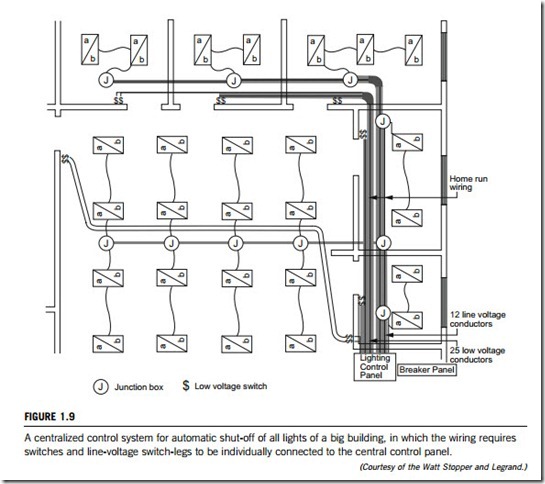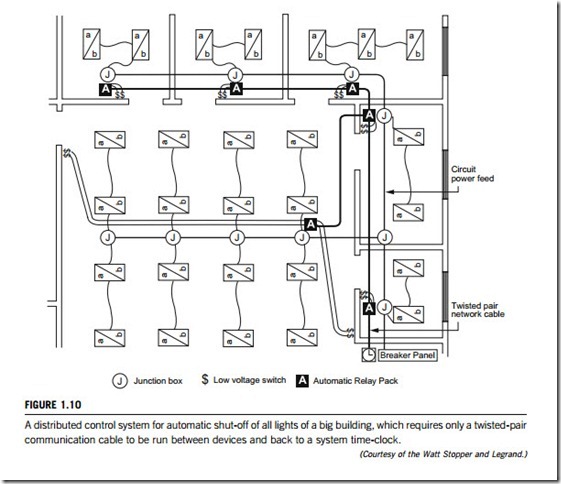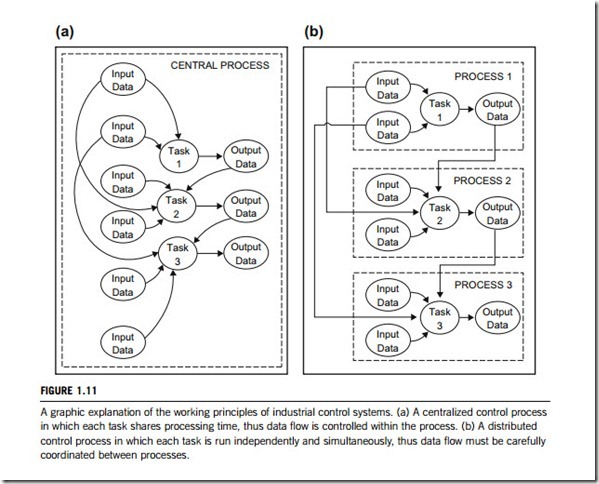DISTRIBUTED CONTROL SYSTEMS
Principles and functions
The distributed control system (DCS) is a concept which is difficult to define. To fully clarify what a distributed control system is, it is helpful to understand the evolution of control system implementation and hardware elements, and how information flow and decision-making developed.
In industry, a control system is a device or set of devices to manage, command, direct or regulate the behavior of other devices or systems. The first type of industrial control system to evolve was a centralized control system in which all information processing is carried out by one particular controller. Figure 1.9 is a graphical description of a centralized control system for automatically shutting-off all lights inside a building. In this system, control panels are used to provide a central platform for switching large numbers of loads. They contain relays with low-voltage inputs from control devices and line-voltage outputs to the load. The system is centralized, with all local switches and switch-legs (sub-circuits) connected to the control panel via line-voltage wiring, and accessory inputs such as photoelectric sensors connected to the panel via low-voltage control wiring. The control panel polls connected control devices for input, which is then filtered through its logic circuit to determine the output (ON or OFF).
Figure 1.10 is another example; this time structured as a distributed control system. In this approach, panel-based control functionality is distributed across the facility. An example is when a control panel is installed on each floor of a multi-story building, and these are networked for control from a master panel, or for convenient access and individual stand-alone control by each floor’s occupants. A completely distributed system would have no control panel in the electrical room. The distributed panels are typically networked via low-voltage cabling to share information, and implement local and global commands based on a shared protocol. For centralized scheduling, these distributed panels can connect back to a system time-clock.
When dealing with real applications of control systems, the location that data are acquired from, and the location to which decisions we conveyed, are both fixed. In contrast, where data processing or decision-making occurs is almost completely arbitrary. In distributed control, processing should be performed where it is most feasible for the goals of the overall system. With this understanding, the control system can be considered as an abstraction into which data enter, are combined and manipulated for some purpose, and are then released back into the environment, which is subsequently altered. The process is then endlessly repeated. The rate at which this occurs is a critical parameter in the efficient functioning of the system.
There are very few systems which can be classified as entirely centralized. For example, many field elements perform some processing, although analog to linearize the data. While a linearized element at field level is not typically considered to be a distributed system element, it does in fact relieve some of the processing burden from a control rule processor. In order to share information between processes, most effectively however, the data must be available in a format which is consistent and unambiguous. Standardized data also require the least amount of manipulation by the receiving process in order to be used. Figure 1.11(a) shows these rationales of a centralized control system. Supervisory control and data acquisition (SCADA) systems are typical examples of a centralized control system.
In the context of some architectures of distributed control systems, the single most important criterion for effective control is data availability. This assumes that each distributed process requires data from a neighboring process to complete its task. To share information between processes most effectively, the data must be available in a format which is consistent and unambiguous. Distributed control systems are those in which processing is performed at the location most beneficial to the overall system goals; information flows throughout the system and is available wherever and whenever it is needed. Information is available in a standard format which is unambiguous to the receiving process. Figure 1.11(b) shows these rationales of a dis- tributed control system.
A commonly accepted definition of a distributed control system is a system which uses decen- tralized elements or subsystems to control distributed processes, or complete manufacturing systems. They do not require user intervention for routine operation, but may permit operator interaction via a supervisory control and data acquisition (SCADA) interface.
Distributed processing and distributed control are becoming unified in control architectures. In distributed processing, functions such as signal processing and data acquisition are distributed, but the control may be centralized, which is hybrid distributed control. In fully distributed control, both processing and the control function are distributed. Thus, we can say that distributed control also implies distributed processing.
Distributed control systems can be classified as open or closed. Open distributed control systems consist of many devices within an open network, which are tuned more to open-source development. On other hand, closed distributed control systems have the devices interconnected within a closed network, which are tuned to traditional, single baseline development. Although distributed control systems are closely linked to device networks, the two are not equivalent. For example, a sensor network with one controller only is not said to be a distributed control system.
In more complex pilot plants and full-scale plants, the control loops number in the hundreds. For such large processes, a computerized distributed control system is more appropriate. Conceptually, computerized DCS is similar to a simple PC network. However, there are some differences. In DCS architecture, the microcomputers attached to the process are known as front-end computers, and are usually less sophisticated pieces of equipment employed for low-level functions. Basically, various parts of the plant processes and several parts of the computerized DCS network elements are connected to each others by means of a data highway (Fieldbus). Typically such equipment would acquire process data from the measuring devices, and convert them to standard engineering units. The results at this level are passed upward to the larger computers that are responsible for more complex operations. These upper-level computers can be programmed to perform more advanced calculations and deci- sion-making.
A schematic of computerized DCS is shown in Figure 1.12, in which only one data highway is shown. The data highway is the backbone of the computerized DCS system. It provides information to multiple displays on various operator control panels, sends new data and retrieves historical data from archival storage, and serves as a data link between the main control computer and other parts of the network. At the top of the hierarchy, a supervisory (host) computer is set. This is responsible for performing higher-level functions. These could include optimization of the process operation over varying time-scales, carrying out special control procedures such as plant start-up or product grade transition, and providing feedback on economic performance.



